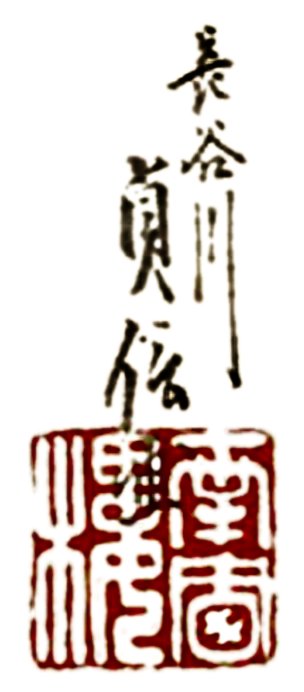| |
HASEGAWA Sadonobu I
|

|
| "Picture
drawn by HASEGAWA Sadanobu" (長谷川貞信 画) with his block seal |
Sadanobu I was a prolific artist, at least by the standards of the Osaka publishing industry. Beginning in 1834, he designed around 200 yakusha-e (actor prints: 役者絵), some counted among the best examples of the period.
Sadanobu also produced a large number of fûkeiga (landscapes: 風景画) totaling roughly 450, including some very small-format mameban ("bean-print": 豆判 ) that were downsized copies of ôban nishiki-e by Utagawa Hiroshige. Sadanobu also produced his own original Hiroshige-style designs, such as the chûban nishiki yoko-e series Naniwa hyakkei no uchi (From the 100 Views of Osaka, c. late 1850s) or the series Miyako meisho no uchi (Famous places in the capital: 都名所之内) from 1870-1871 published by Wataya Kihei (大坂綿屋喜兵衛梓).The influence of both Utagawa Hiroshige I and Utagawa Hiroshige II is clearly evident in the idiomatic visual language, including strolling figures seen from a distance, trees partly interrupting views of the main structures, seasonal foliage and its particular style of coloration, including a vibrant pink horizon line and a gradated blue sky.
Also to be counted among Sadanobu's works, starting in the late 1850s, were some tatebanko ("Standing printing-block models" or dioramas: 立版古), which became something of a Hasegawa artist-family specialty in the late Edo and Meiji periods. One such tatebanko comprised 14 separate sheets meant to be cut up and assembled as a three-dimensional display for the final act of the great kabuki and puppet play Kanadehon chûshingura (Copybook of the treasury of loyal retainers, 假名手本忠臣藏).
In addition to his numerous yakusha-e and fûkeiga, Sadanobu was also involved in many other genres. He produced some kachôga (nature pictures, or bird and flower prints, 花鳥画), and occasionally, warrior prints (musha-e, 武者絵) in mameban format, kodomo-e (pictures of children, 子供絵) in ôban format, jiji-e (current events prints, 時事絵), and chizu (maps: 地図). For some lighthearted fare, Sadanobu designed small-format prints for the series Dôke kyôga zukushi (Myriad crazy pictures from plays, 童戯狂画尽). Moreover, he contributed designs for various book genres, including e-iri nehon (illustrated kabuki playbooks, 絵入根本), kyôkabon (collections of humorous verses, 狂歌本), kokkeibon (popular books of humor or satire with a single story: 滑稽本), hanashibon (popular humorous books with various anecdotes or stories: 噺本), jitsurokubon ("true tale books" or non-fiction, 実録本), and oraimono (primary education textbooks, 往来物). What are most commonly encountered in the book genre are Sadanobu's rather plentiful illustrations for covers and contents of utahon (songbooks, 唄本 or 歌本). He himself acted as Rankô (蘭孝) as a jôruri singer.
Personal life - Sadonobu HASEGAWA I (長谷川貞信 一代 目) (1809–1879), was born as HASEGAWA Bunkichi (長谷川 奈良) in Minami-senba, Andojibashi-dori, Naniwabashi-suji (南船場安堂寺橋通浪波橋筋), in Edo. HASEGAWA Sadonobu's father's name was HASEGAWA Jisuke (長谷川治助) and his mother's name was Rokujo (鹿女). The family delt in high-quality chakin (茶巾 small rectangular cloths used to wipe teabowls during the tea ceremony). The business also operated under the name "Naraya" (奈良屋). Thus Sadonobu childhood name was Naraya Bunkichi (奈良屋文吉) , later changed to Naraya Tokubei (奈良屋徳兵衛). As adopted son of the publisher Tenki in 1843 his official name changed to KONICHI Senzô (小西 専蔵).At a young age, Sandanobu's first employment was as an apprentice in a wholesale shop operated by the main branch of the Hasegawa family called Narachû (良忠) in Kitakyutarô-machi (北久太郎町), Edo, which sold washi (handmade paper: 和紙). When that family business closed, Sadanobu, who by then had already begun his art studies, concentrated on designing ukiyo-e prints.
HASEGAWA Sadonobu was married and had two sons, Tokutarô (徳太郎), as Sadanobu's pupil Konobu I ((二代目 貞信), 11848-1940), and Sadakichi (貞吉), as pupil of his father as Konobu II (二代目 小信, 1866 - 1886). Sadanobu-I died on 28 March 1879 in Osaka.
Aliases - Sadanobu (貞信), Gosôtei (五雙亭), Nansô (南忩), Nansôrô (南忩樓), Sekka (雪花), Sekkaen (雪花園), Sekko (雪江), Shin'ô (信翁), Shiten'ô (信天翁), Kinkadô (金花堂), Yûchô (有長), Yûen (楢園), Ryokuitsusai (緑一齋), and Rankô (蘭孝 as a jôruri singer)
Disciples -
Among his disciples were Sadamasa (貞政 act. c. 1834-1838),
Sadaharu (貞春 act. c. late 1830s-1840), Sekko, Nobuhiro (信廣 act.
c. late 1830s-1840), Munehiro (宗廣 later called Toyohide II, 豊秀,
act. c. 1848–63), Konobu I (一代目 小信 1848-1940 later Sadanobu II:
二代目 貞信) and Konobu II (二代目 小信 1866 - 1886).
Copyright 2008 ff: Hans P. Boehme